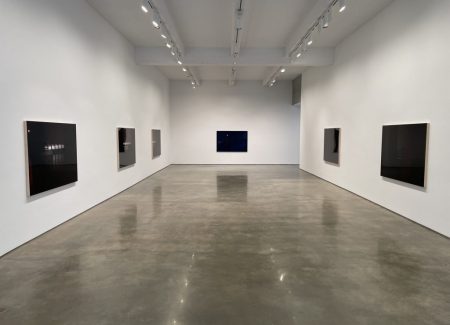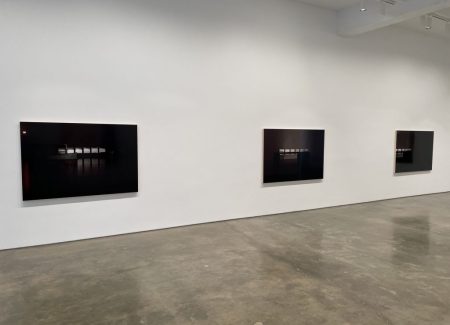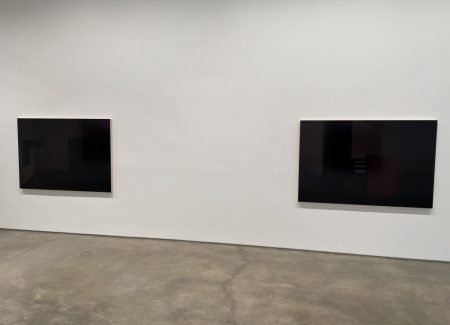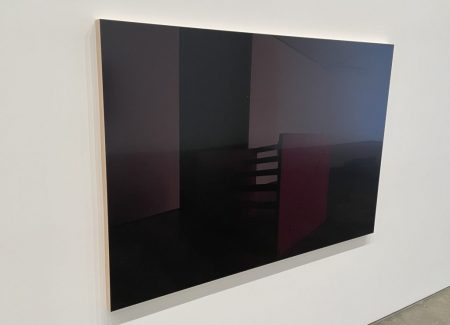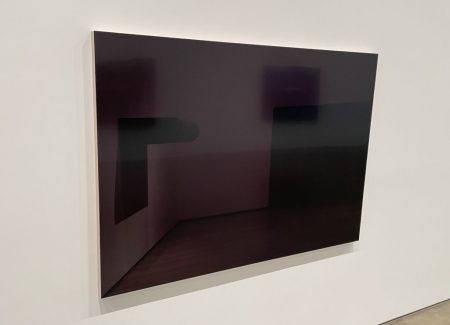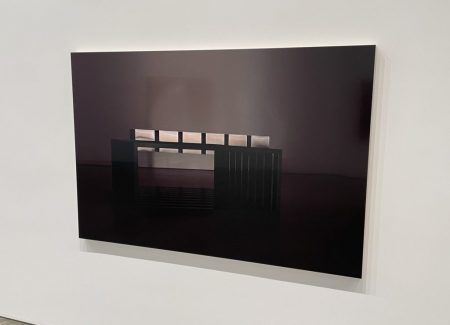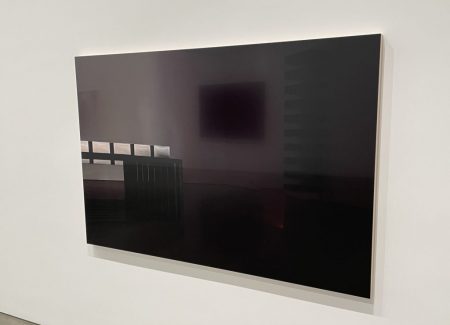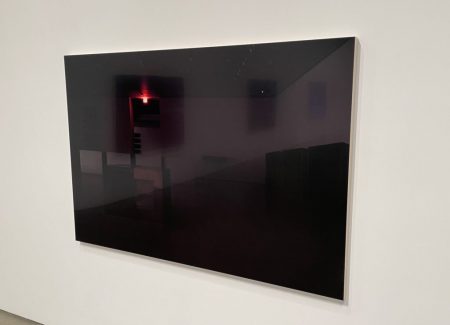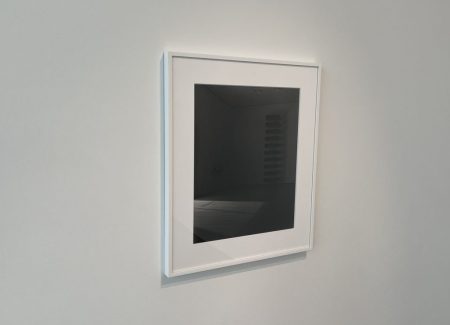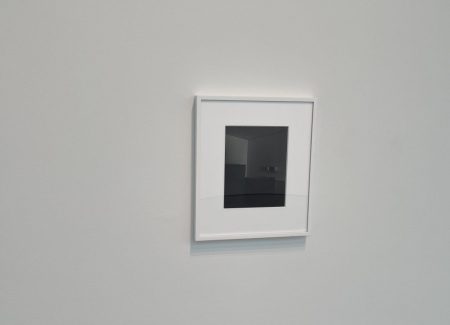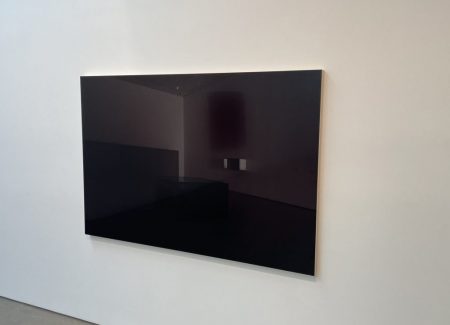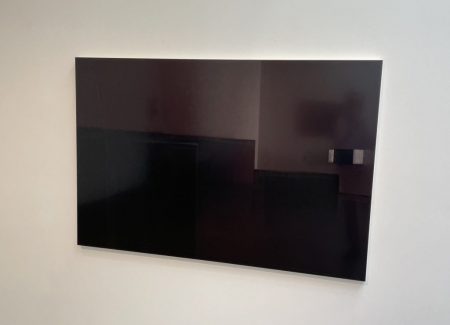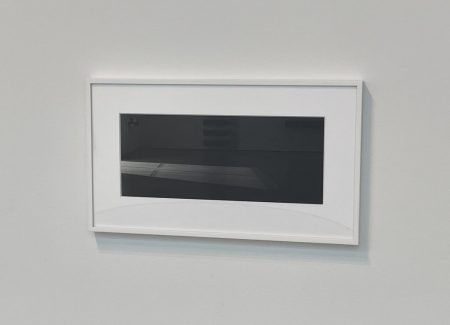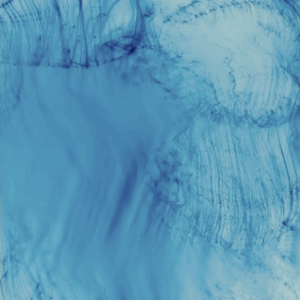JTF (just the facts): A total of 12 photographs, hung against white walls in the main gallery space, the passageway, and the smaller back gallery. 9 of the works are dye sublimation prints on museum box, made in 2021. There unframed prints are sized roughly 48×68 to 48×72 inches, and are available in editions of 6+1AP. The other three works are gelatin silver prints, also made in 2021. These works are matted and framed, are sized between roughly 9×8 and 19×16 inches (or the reverse), and are available in editions of 10+2AP. (Installation shots below.)
Comments/Context: Over her long artistic career, Louise Lawler has shown us artworks installed in a dizzying number of places. Of course, she has captured art in museums and galleries, but she’s also followed it to auction house previews, storage facilities, and people’s homes, where the physical placement of the art and its relationships to other objects nearby get even more layered and complex.
In recent years, Lawler has essentially exhausted the simplest form of that line of thought, at least as far as straightforward photographic interpretations go. Of late, she has been interested in transformation and distortion, and in particular, how her own photographs of installed art can be manipulated, expanded, stretched, and re-installed in new ways. In her most recent gallery show just this past May (reviewed here), she experimented with her “adjusted to fit” wall vinyls and her “traced” outline works, mixing them together in an overlapped installation that added another layer of complexity to the interaction of works in a viewing space. And one step back, her 2017 MoMA retrospective (reviewed here) laid out the broader progression of her ideas.
Lawler’s pandemic-era efforts start exactly where we might expect – in a museum, looking at how art is installed, in this case, at the recent Donald Judd retrospective at MoMA. The difference this time is that she visited the galleries at night, when not only were there no people milling around, the lights were turned off, leaving the various rooms of artworks to settle into an enveloping blackness. Conceptually, she’s discovered yet another way to re-imagine her subject matter, the darkness offering her opportunities to consider spatial interactions where the visual conditions are the opposite of crisp and bright.
Judd’s artworks are exercises in pared down geometric ordering, but also in the ways his objects relate to the space around them, so having them be re-interpreted once again by Lawler is somehow fitting. His retrospective was made up of a lifetime of boxes, stacks, arrays, and other forms, executed in everything from plywood and steel to painted aluminum and Plexiglas, and the artworks were both placed on the gallery floor and hung on the walls, creating interactions and layered views between nearby objects. In Lawler’s hands, these relationships become paramount, and in the dark, they are transformed into something far more elusive and softened than we might have guessed.
The photographs in this show (in both color and black-and-white) don’t really resolve from a distance; they require an up close viewing for the masses of black to reveal their secrets. It’s almost as if our eyes need to slowly adjust to the darkness (even though the galleries at Metro Pictures are brightly lit), and only then, do some of the darkest forms in the pictures become faintly visible. The only light in the MoMA galleries comes from ambient light in hallways, from skylights, and from the red glow of an EXIT sign, leaving Lawler to use those trickles and washes to pull the Judd works out from the blackness.
A series of three Lawler prints creates a sense of gradual movement through the Judd show, with six wall mounted stainless steel boxes catching the light and creating a bright pattern that faintly echoes on the polished floor. As Lawler moves, these boxes move behind other darkly massed works in the foreground, allowing us to catch glimpses of overlaps and connections. Other works find their way into various rooms of the Judd exhibition, where sculptures in different materials play off one another. In one image, what would normally be a bright red painted steel work becomes muted by the darkness, its color only a hint of its usual intensity. In others, open framed works allow us to see through to other stacks and wall mounted works in the background, but the scenes are only partially visible in the dark, the artworks often turned into murky silhouettes or indistinct blocks. In a few works, the scenes are so dark that only after looking at them patiently for a while do a few glimmers of recognition occur as a faint stack of boxes or a vague hard edge or corner emerges from the void.
The physical presence of Lawler’s large prints brings yet another layer or two of interaction into play. These prints are mounted on wooden museum boxes, giving them a more sculptural feel and connecting them back to Judd’s own boxes. Her images are also printed on glossy paper, which reflects the scene inside the rooms at Metro, creating additional black blocks and edges (from her works hanging on the nearby walls and the spatial geometries of the galleries) that then lay atop Lawler’s compositions and confuse them even further. The conceptual nesting is fascinating: Lawler’s images of Judd installed at MoMA, then interrupted by her own prints of that dark encounter as hung at Metro.
In a group of smaller black and white works, the light coming from the sides inside the MoMA rooms is somewhat brighter, encouraging us to see the lines and corners of floors and ceilings as their own geometries that can then interact with Judd’s. These prints are more intimate and tactile that the larger color works, softening the surfaces, making the subtle gradations of light more textured, and highlighting the sense of silence that must have filled the empty spaces. In an sense, these prints are more traditional and less risky than the bigger, color works, but they offer a slightly different perspective on Lawler’s unusual museum experience.
Given that this will be Lawler’s last show at Metro Pictures, which is closing soon after an admirable run, it’s hard not to see plenty of ghosts potentially inhabiting these dark pictures. But for all their eerie spookiness, these are still pictures that fit right into the progressive evolution of Lawler’s art. They reward time spent wrestling with their challenges, getting deeper and richer as the darkness shifts. A quick fly by of this sneakily smart show could likely produce a “turn out the lights, the party’s over” kind of glib black humor, but that would be misplaced. There’s much more to be uncovered in Lawler’s darkness than we might suppose.
Collector’s POV: The works in this show are priced as follows. The color prints on museum box are priced at $90000 each, while the black-and-white prints range from $10000 to $20000, based on size. Lawler’s work is consistently available in the secondary markets, with recent prices ranging between roughly $7000 and $325000.
